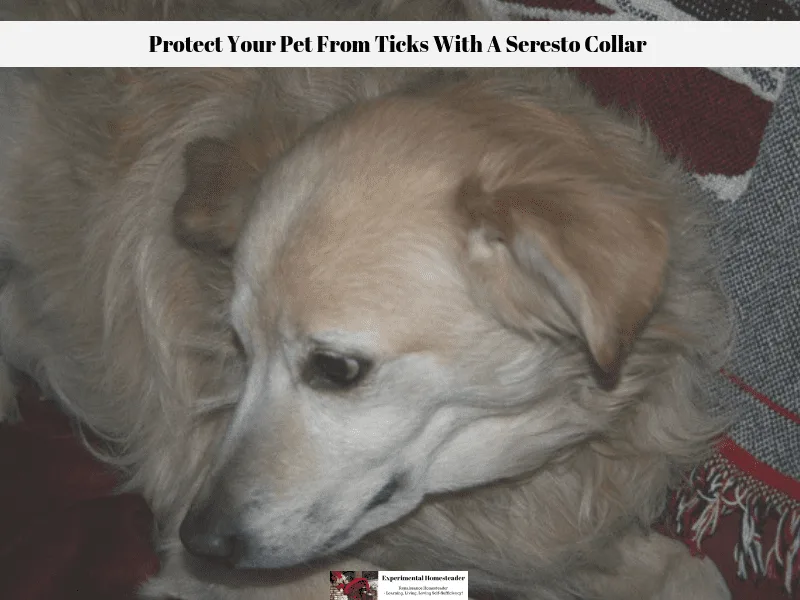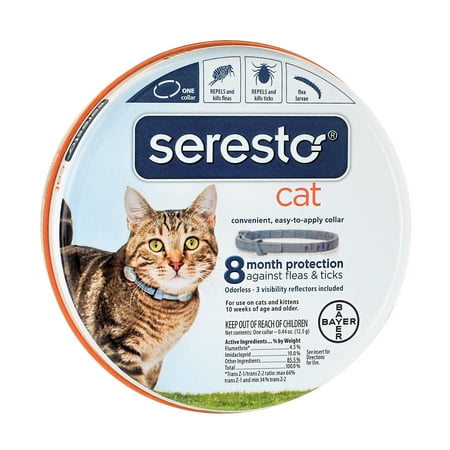Disclaimer: This post is sponsored by Bayer / Seresto and the Pet Blogger Network. I am being compensated for helping spread the word about the Seresto product, but Experimental Homesteader only shares information we feel is relevant to our readers. Bayer / Seresto is not responsible for the content of this article.
It is so important to protect your pet from ticks and a Seresto collar does help. 
Ticks spread disease to both animals and people, which is why preventing ticks in the first place by using a some type of tick prevention such as a flea and tick collar is so important.
The one I highly recommend - and have continued to use even after writing this article is the Seresto Collar, because simply put, it works!
Ticks Are Not Just In the Woods
A huge misconception about ticks is if you don't go into the woods or tall grass and keep your pets out of those areas, there simply won't be a tick problem.
This is not true.
Ticks can latch on to your pets regardless of where they are - even in your own home.
This is why flea and tick prevention is so important.
Seresto Collar Tick Defense Protects Your Pet
The Seresto collar is what I am using to defend my pets from fleas, ticks and the diseases that come along with them.
I choose to use Seresto collars because they protect my fur babies for eight months, do not require messy, monthly applications, the collars are waterproof, odorless and non-greasy.
Best of all the Seresto collars contain Flumethrin which kills ticks within 48 hours of the time you put it on your pet - plus the collars are safe for both dogs and cats.
Protect Your Pet From Tick Hitchhikers
I've always been amazed at some of the places I have found ticks.
On the walls, in the bedding and of course on us or our pets.
I've used preventative methods in the past but they just didn't seem to work well and I often wondered where they were all coming from.
I had never thought of the fact that possibly some of the ticks were hitching rides on the wildlife I was feeding and even scarier, possibly some of my livestock.
Protect Your Pet From Ticks And Protect Your Family Too
PetParents.com lists a host of animals that ticks love to infest.
This list includes raccoons, sheep, horses, cattle, mice, deer and coyotes.
Some of these critters find their way into the city to look for food and this means the ticks come with them.
Once the ticks are there they look for a host to feed on.
This could be you, your loved ones or your fur babies.
This is why prevention is so important.
Protect Your Pets From Ticks Diseases
Ticks carry a number of diseases - some of them life threatening.
In my previous blog post, Seresto Shares Three Important Things To Consider About Fleas And Ticks, I explain about some of the potential dangers that ticks present to both pets and humans including Colorado tick fever, Rocky Mountain spotted fever, 364D rickettsiosis, tularemia, anaplasmosis, ehrlichiosis, lyme disease, babesiosis and powassan disease. Ticks can also cause localized skin reactions.
Protect Your Pets From Tick Season
Cooler temperatures don't mean the end of the tick season either.
Did you know ticks continue to breed in temperatures as low as 40 degrees F?
It is true!
Plus given the fact they love to hide in warm places such as closets, clumps of grass that potentially create a microclimate and outdoor pet houses, you can see why simply relying on cool temperatures to put an end to the tick season isn't sufficient.
Know The Different Between Ticks And The Diseases They Carry
There are three large families of ticks that carry disease in the United States according to the Center For Disease Control and Prevention.
The family types are the Dermacentor, Ixodes and Ambylomma.
A fourth family also exists - the Rhipicephalus which includes the brown dog tick.
This tick carries and transmits the Rocky Mountain spotted fever.
Members of the Dermacentor family of ticks include the Rocky Mountain wood tick, the dog tick, the American dog tick and the wood tick.
Members of this family carry and transmit diseases such as Colorado tick fever, Rocky Mountain spotted fever, 364D rickettsiosis and tularemia which is transmitted to humans by ticks.
Members of the Ixodes family include the western backlegged tick, the backlegged tick and the groundhog tick.
Members of this family carry and transmit diseases such as anaplasmosis, babesiosis, lyme disease and powassan disease.
Members of the Ambylomma family include the lone star tick and the Gulf coast tick.
Members of this family carry and transmit ehrlichiosis and tularemia.
Ticks Live Everywhere, So Protect Your Pet With A Seresto Collar Today
While it is true that not all ticks live everywhere, it is important to be knowledgeable about all of them especially if you or your pet travel.
Remember that an ounce of prevention is worth a pound of cure - and this is why the Seresto collar is right for my pets.
I encourage to get your pet a Seresto Collar today!
Recommended Articles About Dogs And Cats
Easy! Five Steps To Natural Dog Tooth Dental Care
Dog tooth dental care is important for the health of your pet. Learn about these easy natural dog care methods to help prevent dental disease in your pet.
Learn Why My Pet Is My Hero
Sometimes animals come into our life when we need them the most and they always seem to know what we need. Learn why my pet is my hero!
How To Use Coconut Oil In Natural Dog Care Home Remedies
Coconut oil frozen doggie popsicles are a tasty natural dog care home rememdy ideal for skin or coat issues, energy issues and so much more!
Achy Paws™ Self-Warming Dog Mat
The achy paws self warming dog mat did wonders for Precious Angel and his mobility issues when he laid on it. The achy paws warming mat really works!
Fleas Are Dangerous But A Seresto Flea Collar Helps Protect Pets
Fleas are dangerous. They can make your pet really sick and cause skin allergies. The Seresto Collar really does work to rid your pet of fleas and ticks!
Seresto Flea And Tick Prevention Collar
Flea and tick prevention is so important for pets. This is why I am thrilled to tell you about the Seresto flea and tick prevention collar. It really works!
Seresto Shares Three Important Things To Consider About Fleas And Ticks
If you have pets, you know fleas and ticks can be a real problem. Seresto sent me a free collar to try for my dog and some great information to pass along!
Use the buttons on the right side of the screen to share this article with friends or family who might find it useful. Pin the picture below to your pinboard on Pinterest for future reference.













